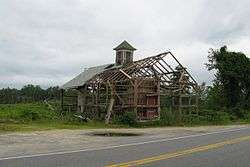Dunwich (Lovecraft)
Dunwich is a fictional village that appeared in the H. P. Lovecraft novella "The Dunwich Horror" (1929). Dunwich is located in the Miskatonic River Valley of Massachusetts, part of the region sometimes called Lovecraft Country. The inhabitants are depicted as inbred, uneducated, and very superstitious, while the town itself is described as economically poor with many decrepit or abandoned buildings.
Origin

Although Dunwich in Suffolk, England is pronounced "DUN-ich," Lovecraft never specified how he preferred his Dunwich be pronounced.[1]
Lovecraft is said to have based Dunwich on Athol, Massachusetts, and other towns in Western Massachusetts,[2] with him specifically citing "the decadent Massachusetts countryside around Springfield – say Wilbraham, Monson, and Hampden."[3] S. T. Joshi has also seen Dunwich as being influenced by East Haddam, Connecticut, location of the "Devil's Hopyard," the "Moodus Noises," and a witch tradition.[4]
Description
Lovecraft places Dunwich in "north central Massachusetts," found by travellers "tak[ing] the wrong fork at the junction of the Aylesbury pike just beyond Dean's Corners." Aylesbury and Dean's Corners are both Lovecraft creations, neither of which appears in any other of his stories, though Aylesbury is mentioned in his poem sequence Fungi From Yuggoth.[5]
Dunwich is described as being surrounded by "great rings of rough-hewn stone columns on the hilltops," which are presumed to have been built by the Pocumtucks.[6]
In popular culture
"The Sun Dog," a novella by Stephen King that appears in the 1990 collection Four Past Midnight, gives passing mention to "a fellow in Dunwich, Massachusetts, to whom Pop [Merrill] had once sold a so-called spirit trumpet for ninety dollars; the fellow had taken the trumpet to the Dunwich Cemetery and must have heard something exceedingly unpleasant, because he had been raving in a padded cell in Arkham for almost six years now, totally insane."[7]
It is featured as the main location for the Arkham Horror: The Card Game as an expansion.[8]
See also
Other fictional settings from the stories of H. P. Lovecraft:
Notes
- Joshi, The Annotated H. P. Lovecraft, note #14, p. 108.
- Liukkonen, Petri. "H(oward) P(hillip) Lovecraft". Books and Writers (kirjasto.sci.fi). Finland: Kuusankoski Public Library. Archived from the original on 13 July 2006.
- November 6, 1931 letter to August Derleth
- Lovecraft, Howard P. (1984) [1928]. "The Dunwich Horror". In S. T. Joshi (ed.). The Dunwich Horror and Others (9th corrected printing ed.). Sauk City, WI: Arkham House. ISBN 0-87054-037-8. Definitive version.
- Joshi, Index to the Fiction & Poetry of H. P. Lovecraft, pp. 11, 17
- The Dunwich Horror
- King, Stephen (September 1991) [First published 1990]. Four Past Midnight (MMP). New York City, NY: Signet/Penguin. p. 657. ISBN 0-451-17038-5.
- "Arkham Horror: The Card Game". www.fantasyflightgames.com. Retrieved 17 February 2018.
References
- Lovecraft, Howard P. (1984) [1929]. "The Dunwich Horror". In S. T. Joshi (ed.). The Dunwich Horror and Others (9th corrected printing ed.). Sauk City, WI: Arkham House. ISBN 0-87054-037-8. Definitive version.
- Lovecraft, Howard P. (August 1997). "The Dunwich Horror". In S. T. Joshi (ed.). The Annotated H. P. Lovecraft. New York, NY: Dell. ISBN 0-440-50660-3.
External links
- "The Dunwich Horror," by H. P. Lovecraft. The original story featuring the first appearance of Dunwich.